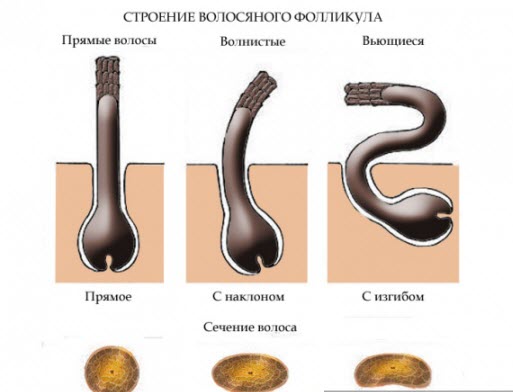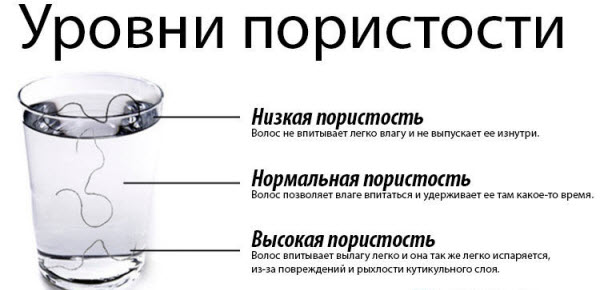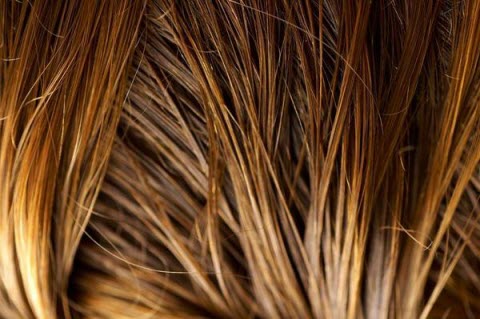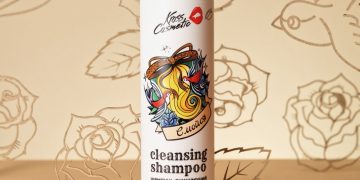How to determine your hair and scalp type
Determining your hair type will help you understand how to choose home hair care more effectively so that it really works, what haircuts to choose, and how best to style your hair.
Hair type involves understanding several qualities of hair, including thickness, structure, porosity, and elasticity of the curls.
And so, today we will determine the shape, structure and type of hair ...
Hair shape
Let's start with the shape of the hair, since it is defined in the womb.
The structure of the hair follicle (location and shape) determines what our hair will be, if it is round, then the hair is straight, if it is oval and oblique, bean-shaped and curved - curly and curly.
You are born with either naturally curly (curly) hair or straight hair. The number of curls, waves or their absence depends on the number of disulfide bonds between hair proteins found in the hair shaft, the more the number of links, the more curly the hair and the fewer the number of links, the straighter the hair.
Hair is mainly composed of keratin, a protein that grows from the follicle. Keratins and other proteins are produced in the cells of the hair follicle. All proteins become part of the hair shaft and contain sulfur atoms. When two sulfur atoms combine and bond, they form a disulfide bond. If two sulfur atoms in the same protein are at a distance and connect to form a disulfide bond, the protein bends. This is how your curls are created!
How to determine hair structure
Hair structure is the thickness or diameter of the hair, there are three types of structure: thick, medium and thin hair. It is quite normal when different hair thicknesses can be found on different areas of the head.
The shape of the hair does not affect its structure, curly hair can be of either thin or medium thickness, straight hair also.
How to determine what hair shape you have?
- Wash your hair as usual using shampoo and conditioner. Rinse them off very thoroughly. Choose a time when you are not exercising or cooking so that you do not sweat extra, which can change your results.
- Allow your hair to air dry naturally, do not use a hairdryer, pat dry with a towel (but do not rub) and let it dry. Do not use styling products.
- Take regular sewing thread, 15-20 cm long. Choose regular thread instead of thicker thread for sewing heavier fabrics.
- When the hair is completely dry, take a section of hair. The crown of the head is the best area to grab a strand from.
- Place the strand and strand of hair on white paper. Use a sheet of white paper to clearly see the strand of hair and the thread so that it is easier to compare. Compare a lock of hair to a thread. Take a close look at your hair:
- Thin hair: if a strand of hair is thinner than a strand, you have fine hair.
- Medium hair: if your strand is about the same thickness as the strand, you have a medium hair texture.
- Thick hair: if the strand of hair is thicker than the strand, you have thick hair.
Knowing this will help you better determine what types of foods you should look out for. For example, coarse hair has a large texture and often does not hold water like other hair types. For those with coarse hair, more moisturizers should be used to moisturize these strands and prevent frizzy hair.
Determination of hair porosity
Porosity refers to the ability of your hair to absorb moisture or a product (mask, conditioner, balm). Knowing how porous your hair is can help you determine which products should be in your arsenal to improve its condition.
An easy way to determine the porosity of your hair is to place one strand of hair in a glass of water. If your hair sinks to the bottom, your hair has a high porosity as it absorbs all moisture.If your hair floats on the surface of water, your hair has low porosity and does not easily absorb moisture. Finally, if the hair is floating somewhere in the middle of the water, it has normal porosity, which means it is well balanced.
It is good if your hair has low porosity, which means that the cuticles are flat, pressed against each other and water is not absorbed into them. Those with low porosity often find their hair takes longer to dry and that products tend to accumulate on the hair rather than being absorbed. To avoid this, distribute the conditioner evenly through your hair and apply it to slightly damp hair, then rinse thoroughly.
If you have very porous hair, then your strands may have cuticle breaks, which can be the result of chemical exposure to the hair, blowing, ironing, or other damage. This means that when you apply the product, your hair quickly absorbs it, but also releases it just as quickly. People with high porosity find that their hair dries quickly, but they are not hydrated and nourished enough. For this type of hair, try to avoid heat, sun, blow dry, iron. Look for products that will nourish, repair, and moisturize your hair well.
Determination of scalp oiliness
- Wash your hair as usual using shampoo and conditioner. Rinse them off very thoroughly. Choose a time when you are not exercising or cooking so that you do not sweat extra, which can change your results. Let your hair dry naturally and do not use styling products.
- Walk for about 8-12 hours, and it is better to spend the night and check in the morning, so you can more accurately determine the degree of oily hair. In the morning, press the napkin to your head at the top of your head and then behind your ears. Do not rub, light pressure on the scalp is sufficient.
- Greasy hair: if there are oily residues on the fabric, then you have oily hair.
- Medium hair: if you see oily marks on the napkin, you have medium hair.
- Dry hair: if there is nothing on the fabric, then you have dry hair.
- Combined hair: if there was no oiliness on one part of the head, and on another, it means you have combination hair.
Check your hair again another day. The weather can affect your hair; for example, if it is very damp, your hair may react slightly differently than on a drier day.
How to choose hair care according to your hair and scalp type
When choosing products, it is important to take into account the condition of the scalp and the length of the hair (shaft)!
If you don't know your hair type, then you may not be able to find the right home hair care.
Dry, oily, normal and mixed hair type is not entirely correct definition of hair type, because you need to take into account the condition of the scalp and hair length, so the correct hair types will be disassembled like this:
Normal skin + normal hair
This is the perfect combination, and it is worth striving for, and so what care:
- shampooing once every 2-3 days, shampoo is suitable for almost any
- application of peeling (scrub) once every 2 weeks (deep cleansing shampoo can be used)
- Balm, conditioner after each wash (series: moisturizing, nutrition, shine)
- Masks once a week: moisturizing, nourishing, smoothing, sometimes it is possible to restore shine
Normal skin + dry hair
- shampooing 1 time 2-3 days, alternate shampoos: soft, sulfate-free
- application of peeling (scrub) once every 2 weeks (deep cleansing shampoo can be used)
- balm, conditioner after each wash, it is possible with silicones, they are indispensable for dry hair length
- masks 1-2 times a week: regenerating, nourishing
Dry skin + dry hair
Although rare, this type of hair is also found, it requires careful delicate care:
- shampooing 1-2 times a week, with mild shampoos, for sensitive scalp, neutral
- application of peeling (scrub) once every 3-4 weeks (you can deeply cleanse shampoo) and then if the scalp tolerates them normally
- balm, conditioner after each wash, it is possible with silicones
- masks 1-2 times a week: regenerating, nourishing, moisturizing
Oily skin + normal hair
- shampooing daily or every other day, shampoo marked "for oily hair"
- application of peeling (scrub) 1-2 times a week (deep cleansing shampoo can be used)
- balm, conditioner after each wash
- masks 1-2 times a week: nourishing, moisturizing, for volume
Oily skin + dry hair
- shampooing daily or every other day, shampoo marked "for oily hair", sometimes you can use a neutral shampoo
- application of peeling (scrub) 1-2 times a week (deep cleansing shampoo can be used)
- balm, conditioner after each wash, it is possible with silicones
- masks 2 times a week: regenerating, nourishing, moisturizing
In every type of hair, additional care must be present. Oils, fluids, creams for hair ends. Thermal protection before each drying with a hair dryer, in the form of a cream, spray. Serum courses, tonics to strengthen hair.
When shopping for any hair product, pay attention to all the key terms by hair type.

 home
home All articles
All articles



















